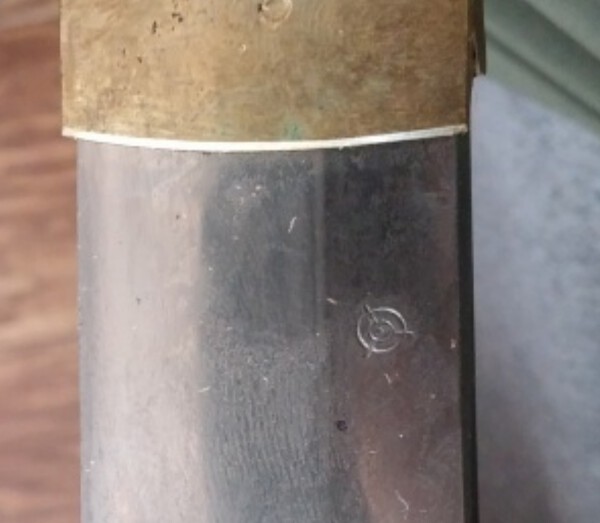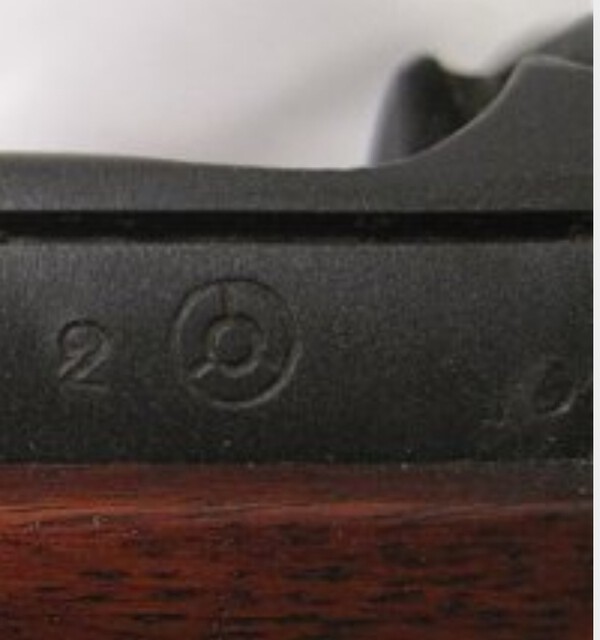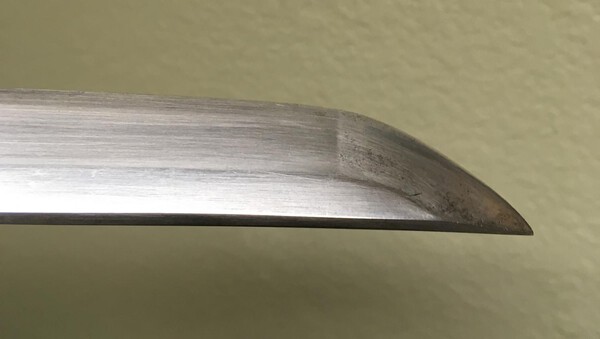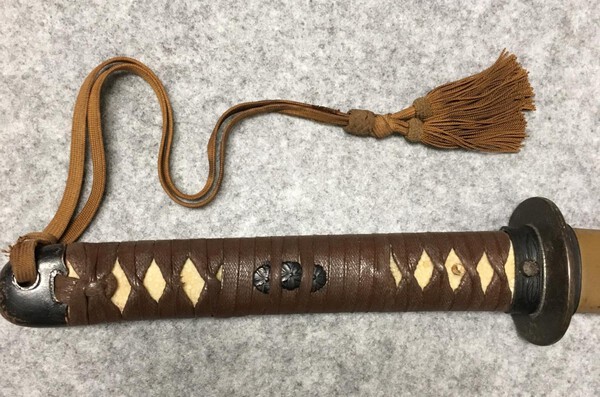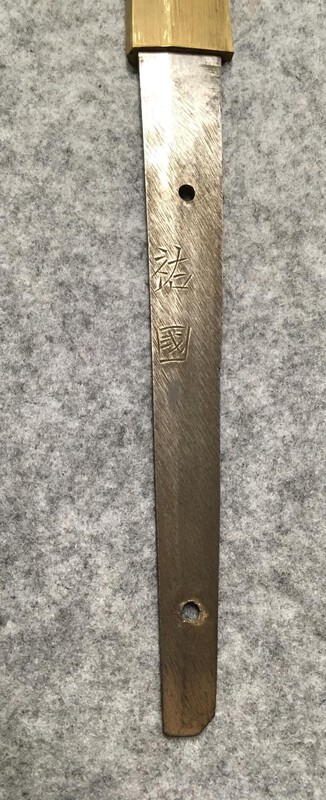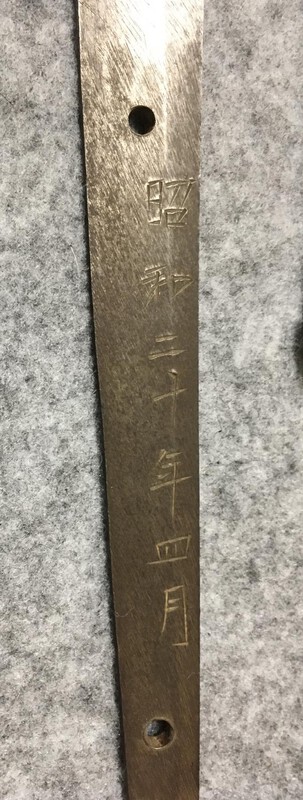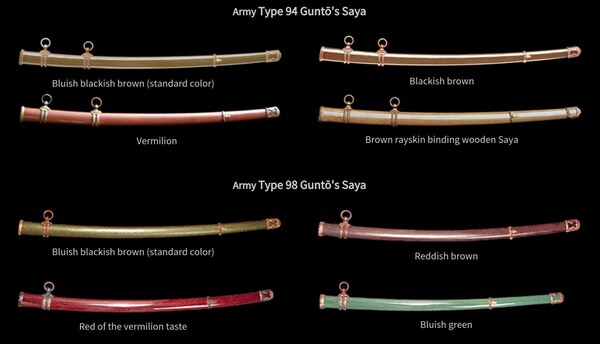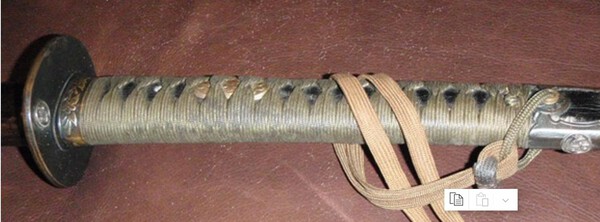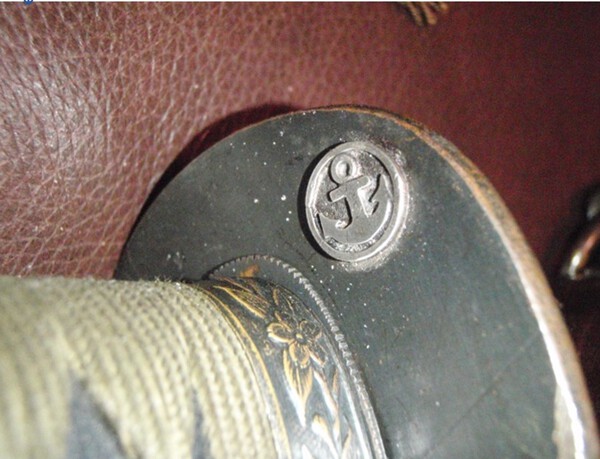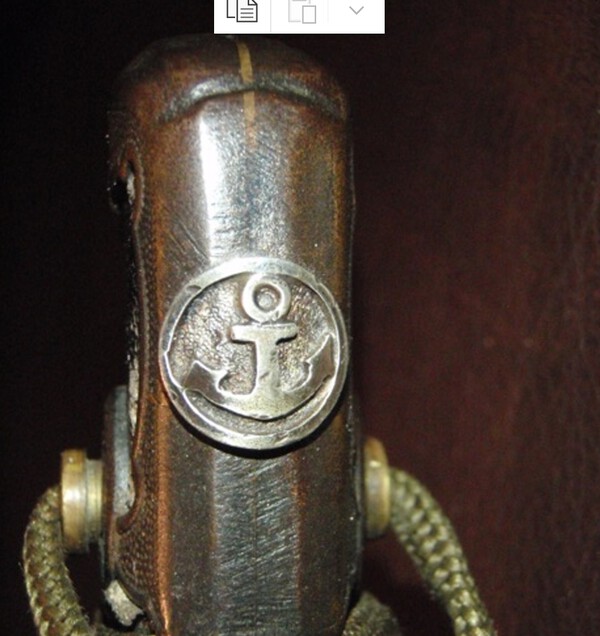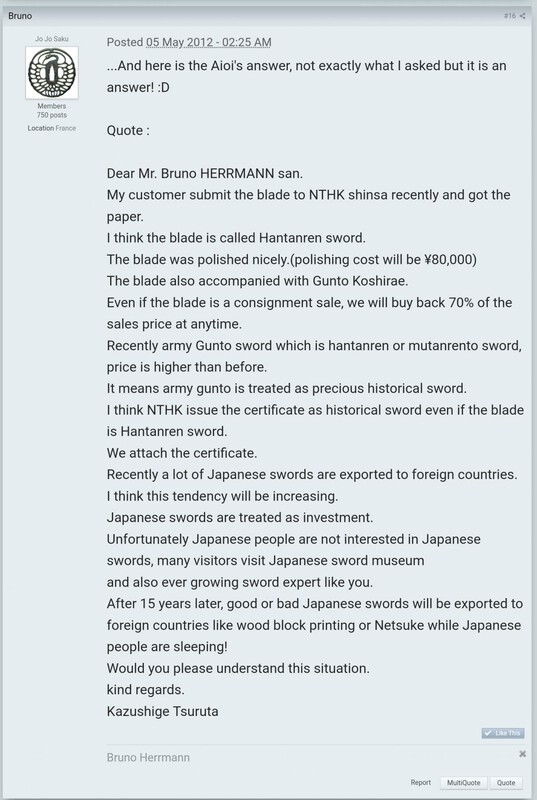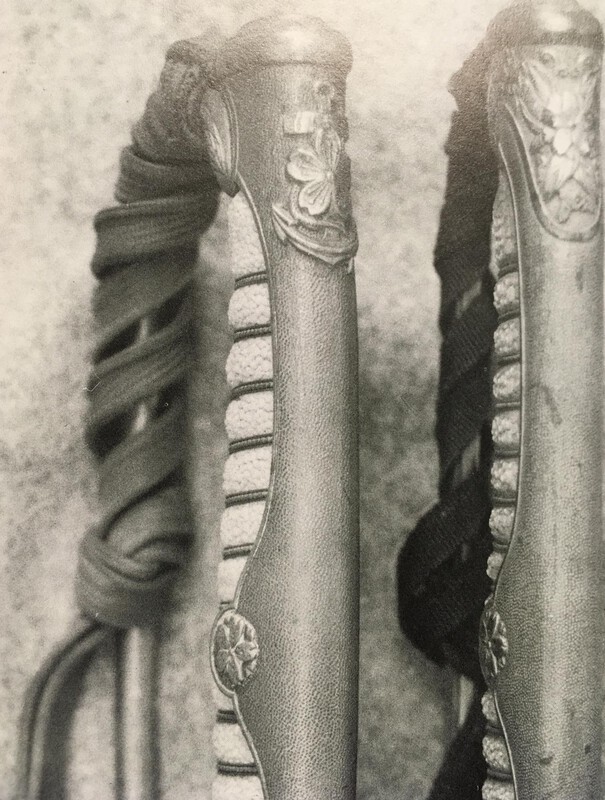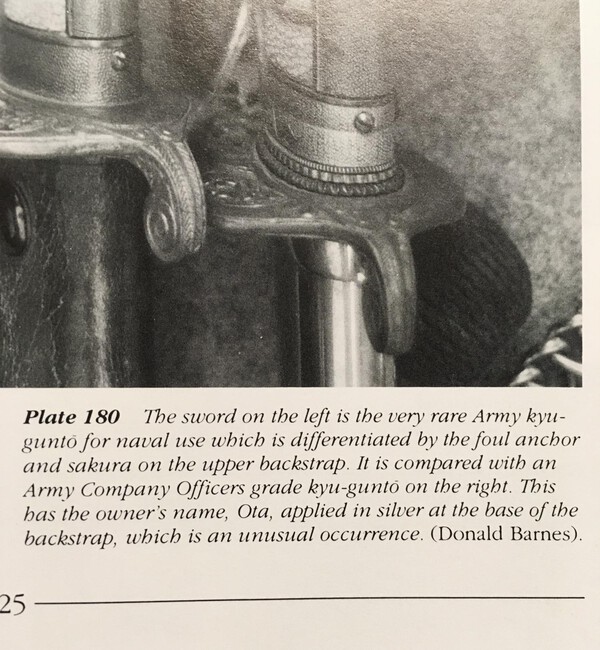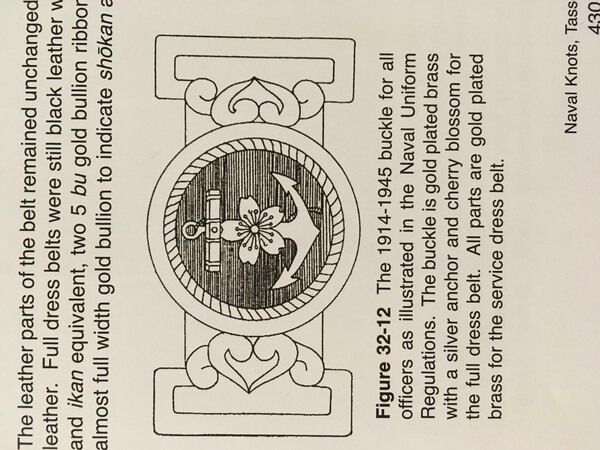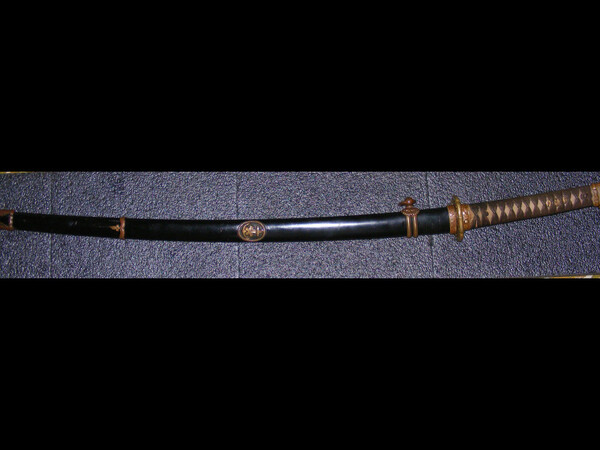-
Posts
12,994 -
Joined
-
Last visited
-
Days Won
155
Content Type
Profiles
Forums
Events
Store
Downloads
Gallery
Everything posted by Bruce Pennington
-
Tom, Sometimes it’s necessary to grab the peg with pliers and pull it out. I have one that is that way. The wrap may be blocking its exit on the other side, or the holes in the tsuka and nakago aren’t aligned perfectly and the peg sits at an angle.
-
Alamo, Forum rules (plus we all like talking real people!) - go to your settings and put in a first name, or sign a name at the end of each post, thanks! Type 98 Japanese officer's sword in combat saya (scabbard). The combat saya often means there is an older blade in there. No way to know until you take out that bamboo peg holding the tsuka on the blade. Once that is pushed out, the handle and tsuba/seppa will all come off. Then you can get some good pics of the nakago (tang), blade pointed up. The fittings are nice, so there might be something cool under that tsuka!
-
Dave, I've never heard - how do you pin the age of a leather cover?
-
Yeah, I think that's called "Bubba-ayasugi"!
-
Dawson, Fuller, and Ohmura all refer to the "Mukden" or "Nan-man" arsenal. Located 10 miles north of the city, they also call it the South Manchurian Arsenal (not to be confused with the South Manchurian Railway Factory). Dawson says they made swords, but didn't know of what nature. Fuller says they used the "Nan" stamp. Ohmura associates both the Nan and Ren stamps with them, and believes they were involved with Mantetsu blades. None of them refer to the circled Mukden stamp seen on firearms and baynets, although Fuller shows the stamp in his chart, saying not all the stamps in the chart are seen on blades. This COULD be a post-war Bubba-job, as proposed by someone on Warrelics. It's dated and signed ('44 Kanesada), with no stamps on the nakago, so I can't imagine WHY a Bubba would create his own stamp and put it on the blade; although the Bubba's of the world have done some inconceivable things!
-
Came across this thread from 2016, on NMB (http://www.militaria.co.za/nmb/topic...-quality-help/) with a stamp on the blade resembling the Mukden stamp found on firearms and bayonets, but it's not what I'm used to seeing. Anyone see this as a Mukden stamp, or is it something else? This is what the Mukden stamp looks like on firearms
-
I recall there are a few new guys starting their collections, and there are some who specifically collect Type 3 Contengency models, so I wanted to get the word to our group before it goes to a fleabay buyer. It's a 1945 Sukekuni, great condition. I've got pics on the For Sale forum: http://www.militaria.co.za/nmb/topic/28784-type-3-44-model-contengency-model-excellent-condition/ I don't normally sell my gunto, but this is for the Mrs for Mother's Day, so not much room for negotiation! {Brian (or Admin) if it's inappropriate to notify guys this way, on this forum, I understand, and will understand if you delete.}
-

Type 98 with an old tachi mei blade
Bruce Pennington replied to EdWolf's topic in Military Swords of Japan
Wow, that was originally one seriously long nakago! Agree with John on the saya. Ohmura has one the same color. I love the seppa. Wonder if they came from the "civilian" fittings? -

Koa Isshin With Nthk Papers
Bruce Pennington replied to PNSSHOGUN's topic in Military Swords of Japan
Final installment on terms from Nick: "To a normal Japanese person, Nihonto 日本刀 simply means Japanese-style sword, in comparison to Yoto 洋刀 or Western-style sabers. But sword collectors developed the additional words you mentioned as collector jargon and then for gun and sword control laws a separate legal definition became necessary in connection with what constitutes artistic value. So meanings will change depending on whether you are talking with a layman, collector or lawyer, but Nihonto has the first meaning in 99% of the cases." So, it boils down to simply getting the group we converse with regularly to agree on terms. They, as all words, are created to convey an idea. They simplify. Instead of saying "I just bought my first Japanese sword made with tamahagane without any hydraulic hammers" we can say "I just bought my first nihonto" etc. -

Koa Isshin With Nthk Papers
Bruce Pennington replied to PNSSHOGUN's topic in Military Swords of Japan
A follow-up from Nick: "Kyugunto" and "Shingunto" are not historical terms. Throughout Japanese military history, any outdated military sword was called a Kyugunto and the latest model a Shingunto. Thus the Type 32 was also naturally referred to as "Shingunto (new model sword)" when that was the current model. So what specific model you are referring to is all a matter of where you want to freeze the picture in the flow of time. Those using that lingo have decided to pin themselves down to 1945 and by doing so lose relevance to the modern day perspective and language. Current Japanese refers to Japan's WW2 military in its entirety as "Kyugun", so for a normal Japanese speaker all swords belonging to the IJA and IJN are "Kyugunto". I'm checking with him for clarity on Nihonto, Gendaito, and Showato. -

Koa Isshin With Nthk Papers
Bruce Pennington replied to PNSSHOGUN's topic in Military Swords of Japan
Here’s the official word from Nick Komiya, Warrelics: “No, Gunto means "Military Sword" and refers to its whole structure "Lock, stock and barrel" so to speak. An Army sword is Rikugunto and by the same principle, a Navy Sword is Kaigunto. If you wanted to say "Military sword fittings" you would have to say either "Gunto no Gaisou" or "Gunto no Koshirae". Defining gunto as a "sword in military fittings" is also acceptable, but not really to the point.” -

Koa Isshin With Nthk Papers
Bruce Pennington replied to PNSSHOGUN's topic in Military Swords of Japan
There are separate words for the blades in military fittings - nihonto, gendaito, showato - and these words apply regardless of the koshirae they are fitted out with. A family sword, whether 100 years old or 500, once bought buy or donated to the war department became a military possession, therefore an army sword or navy sword. A nihonto in military fittings is a gunto or kaigunto as is a showato in the same fittings. They have become war swords owned by the government - gunto. -

Koa Isshin With Nthk Papers
Bruce Pennington replied to PNSSHOGUN's topic in Military Swords of Japan
Interesting David. I looked it up on The Japanese Sword Index and they agree: “GUNTO - army or military sword mountings” I had always been told that “gun-to” meant “army-sword” so it’s weird that the word is actually applied to army koshirae (KOSHIRAE - sword mountings or fittings). Seems odd. -

Attention Mantetsu Owners: A Survey
Bruce Pennington replied to Bruce Pennington's topic in Military Swords of Japan
A minor update on the Mantetsu mei dateline. I've found a '39, chopped to waki size, but having bothe the Dalian Railway Stamp AND the Koa Isshin mei. It's a Spring of '39 so there might have been a transition early in the year where both appeared together. So for now, here's the mei timeline: Showa 13 (1938) Winter - Dalian Railway Stamp; no mei Showa 14 (1939) Spring – Dalian Railway Stamp; 興亜一心 (Koa-Isshin) 満鉄作之 (Mantetsu Saku Kore) Showa 14 (1939) to Showa 16 (1941) : 興亜一心 (Koa-Isshin) 満鉄作之 (Mantetsu Saku Kore) Showa 17 (1942) : 興亜一心 (Koa-Isshin) 満鉄謹作 (Mantetsu Kin-Saku) Showa 17 (1942) to Showa 18 (1943) : 興亜一心 (Koa-Isshin) 満鉄作 (Mantetsu Saku) Showa 18 (1943) to Showa 19 (1944) : 満鉄鍛造之 (Mantetsu Tanzo Kore) Showa 19 (1945): 興南一誠 (Kou-nan issei) [only 1 example] -
Is that chome flaking on the blade? I don't think I ever seen a chromed fake before. But if its just normal corrosion on steel, then never mind. The islanders of SE asia DID make their own swords during the war, so that's a possibility. It would be nice to know the the kanji on the habaki are legit or jibberish. Jibberish would lock it in as fake.
-

Mantetsu Suriage Or Wak?
Bruce Pennington replied to obiwanknabbe's topic in Military Swords of Japan
I was reviewing this discussion and noticed the hamon carries around the curve of the kissaki, meaning the tip wasn't shortened, so for the nagasa to be shorter than standard, someone had to move the hamachi and munemachi. This is not hard, I guess for a professional. Anyone know if there is a way to tell? I agree with Kurt that the mei is correctly placed around the mekugi-ana. Is there a standard distance from the ana to the machi? If the machi were moved, this might show in the measurement? -

Anchor Mon On Rinji (Type 3)
Bruce Pennington replied to Bruce Pennington's topic in Military Swords of Japan
Update: Shared this discussion with Richard Fuller. He passed these pictures of a gunto with the identical set-up as Edward's. Here's his thoughts on it: "My guess is that was used by the Etajima Naval College or other naval education establishments for drill lessons but would need to be carried by adult students. Have not been able to find the significance of the foul anchor variations." This quote came with the pictures: "The plain anchor-in-circle is the cap badge of Navy Preparatory School students so it is possible this sword was owned by such a school. Possibly used for sword etiquette training or parade purposes. Ted Simpson, U.K." -

Koa Isshin With Nthk Papers
Bruce Pennington replied to PNSSHOGUN's topic in Military Swords of Japan
Thanks Eric! Hate to say it, but I didn't even know there was a difference. It's a world I'm totally ignorant of. I'm sure you're right David, but I, for one, don't have the time, money, or interest. WWII militaria is all I can manage. It's like everything else, some people can stare all day at a Picasso - I'd rather look at a perfectly done Philipino painting of a dafodil. I see the beauty of nihonto, it's just not my area of interest. -

Japanese World War 2 Sword Help
Bruce Pennington replied to leobrb's topic in Military Swords of Japan
Is it "Leo"? Need to go to settings and post a name for us, thanks. Both your examples are poor fakes, so it's a good thing you asked first! I agree with John that you CAN find something for $750, but not something in great shape. Even the NCO blades have gone up in the past year. You can find some Type 32s and Type 19s under that price. Both of Chris's recommendations are great. The auction houses I've shopped tend to sell at top dollar, so I doubt you'll get anything cheap that way. Crimson Mist sometimes has some reasonably price gunto: http://www.cmmilitaryantiques.com/search.php?pcat=3 Gunto Art Swords have quality gunto, but prices usually reflect that (I have bought 2 from him, at above market rates, but both were fabulous and I HAD to have them!): http://www.guntoartswords.com Here is one that is legit (I had to search through 4 fakes before I found this one!) https://www.ebay.com/itm/EXCELLENT-WWII-Japanese-Samurai-Sword-NCO-SHIN-GUNTO-Katana-World-War-2-BLADE/223497999128?hash=item340984d318:g:Oe0AAOSwUvVcxSFN&redirect=mobile -

Koa Isshin With Nthk Papers
Bruce Pennington replied to PNSSHOGUN's topic in Military Swords of Japan
Neil, I agree fully. Sure, the showato maybe shouldn't reach the higher levels of the ratings as they gendaito smiths works really are different in the art of the craft, but some showato have real art as well, and some, like the Mantetsu were so good there was a waiting list of officers wanting them. Yes, it was actually a NTHK papered Mantetsu that started this discussion. -

Koa Isshin With Nthk Papers
Bruce Pennington replied to PNSSHOGUN's topic in Military Swords of Japan
Found a similiar discussion from 2012: http://www.militaria.co.za/nmb/topic/9526-showato-in-Japan/ Someone actually got a response for the team: It verifies what we've learned here, that they are papering for "historical" reasons. He lamented the fact that "Japan sleeps" while these precious items are being shipped out of country to collectors abroad. -

Anchor Mon On Rinji (Type 3)
Bruce Pennington replied to Bruce Pennington's topic in Military Swords of Japan
Thanks Bryce! I offer the following as a "possible" solution: Fuller & Gregory have a kyugunto that he calls "army kyu-gunto for navy use". The kyu is obviously not faked, so there must be a reason and army sword is marked with a navy anchor. Whatever that reason is - is probably behind these gunto with anchors. We can specualate about shortages or other ideas, but I beleive, like I stated above, fakers copy real stuff. So what there WERE real ones. The fact that we don't know the WHY doesn't invalidate their existance. On a side note, the one on the saya is the same as the one in Dawson's book from a navy belt. Note the rope around them both. Interesting topic. -

Anchor Mon On Rinji (Type 3)
Bruce Pennington replied to Bruce Pennington's topic in Military Swords of Japan
Found this on an old thread (pg 46). Thought I'd add it as is generates similar questions: Thread found here: http://www.militaria.co.za/nmb/topic/6879-unusual-shingunto/ -
It's been a while since I posted the latest version of my Stamps document. Ver 1.8 has a few kakihan added, and the latest "Company" stamp found on a Type 95 drag. As Fuller's chart on hotstamps and kakihan are hand drawn, I thought I'd start collecting actual examples. I've got 6 already, but could use real examples of: Kanenari Ishihara Nyudo Kanetaka Kojima Katsumasa Nagamura Kiyonobu Nagamura Kiyonubo (with "fuji" kanji) Suetsugu Shigemitsu Fujiwara Yoshikane Kanesaki Itsuryushi Tohimitsu
-

New sword variant discovered?
Bruce Pennington replied to IJASWORDS's topic in Military Swords of Japan
Steve, looks like a standard, rusty Rinji/Type 3/Type 0/'44 model missing the ito.



